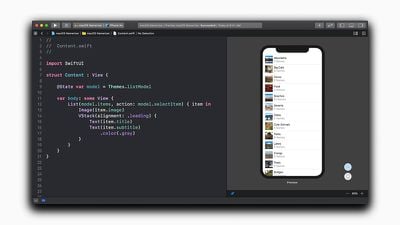On the latest episode of the AppStories podcast, MacStories editor-in-chief Federico Viticci sat down with Apple's software engineering chief Craig Federighi to discuss WWDC 2019 announcements, including Project Catalyst, SwiftUI, and iPadOS.

Project Catalyst will make it much easier for developers to extend iPad apps to the Mac. In many cases, adding macOS support to an iPad app is as easy as opening an Xcode project and clicking the Mac checkbox, although Apple encourages developers to further optimize their apps to offer a true Mac experience.
Federighi believes Project Catalyst will allow many developers to bring their iPad apps to the Mac, as Apple has bridged the gap between its UIKit framework for iOS apps and its AppKit framework for Mac apps:
UIKit and AppKit always remained these two separate worlds, and depending on what a developer did, they could build an app that was sort of factored in a way that they shared a lot of cross-platform code, but they had to always take that extra step of having people on the team that knew AppKit, people on the team that knew UIKit, and make the decision to specialize for those two. And for many developers, they chose one or the other and not both, because that was a real effort to get the expertise and to make the investment.

Federighi expressed excitement about Project Catalyst, noting that he has seen many apps that look fantastic on the iPad that he has wanted on the Mac. With macOS Catalina and Xcode 11, that is now a possibility, with Twitter being one of several companies that plans to extend their iPad app to the Mac.
He added that Project Catalyst gives Apple the "same kind of benefits of being able to have a single team that can focus on making one thing the best and release it across all of our platforms," which makes "a ton of sense" to the company.

As for Apple's new SwiftUI framework, which enables developers to use easy-to-understand declarative code to create full-featured user interfaces, Federighi said giving developers a tool that is "that expressive and that interactive" is going to result in better ideas and thereby better apps moving forward:
SwiftUI will make development of UI more accessible to many people who maybe weren't approaching it before, and that's exciting, because we're already seeing some of that with Swift and Swift Playgrounds. But even for the most experienced of developers, giving them a tool that is that expressive and that interactive is going to mean they're going to build better things, they're going to try out better ideas, and that's going to result in better apps.
Turning to the new iPadOS platform, Federighi said that the iPad has "become something really distinct from the phone" over the years and, accordingly, was deserving of an operating system that provides a "distinct experience":
Things like Drag and Drop, Split View, Slide Over, Apple Pencil… these are things that really define a different way of working with the device. When I work on my iPad, I don't feel like I'm working on a big phone… or like I'm working on a Mac. I feel like I'm working on an iPad. What we mean when we say macOS, or when we say tvOS, which is an iOS-based platform, or when we say watchOS, which at its core is iOS, these things to us are definitions of experiences. There's a watchOS experience that's tailored for apps that make sense on your wrist. tvOS, a 10-foot UI that makes sense in that context. iPadOS has become a distinct experience. We've been working our way there steadily over time. With the work we did this year, we felt like we were at a place where this truly was a distinct thing.

Humorously, Federighi also poked fun at the iPad's newly added support for external storage such as USB drives and SD cards:
External drives. We're willing to acknowledge the 1990s and go all the way back. You know, people still use them sometimes. I'm an AirDrop fan myself, but I understand there are other uses… we know with photographers, the ability to import their photos directly into an app like Lightroom is so important.
The full interview can be listened to on the AppStories podcast over at MacStories.





















